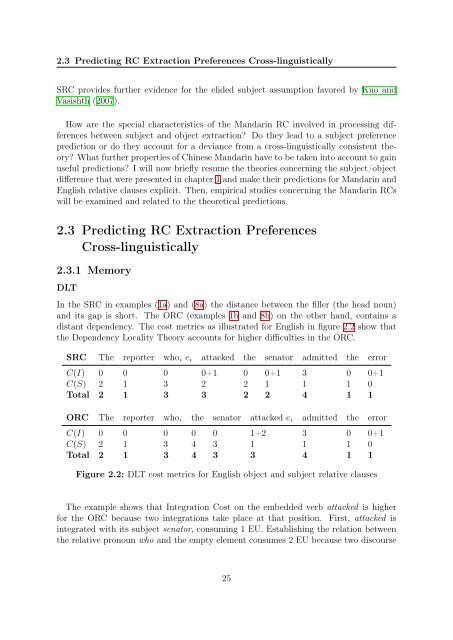Connectionist Modeling of Experience-based Effects in Sentence ...
Connectionist Modeling of Experience-based Effects in Sentence ...
Connectionist Modeling of Experience-based Effects in Sentence ...
Create successful ePaper yourself
Turn your PDF publications into a flip-book with our unique Google optimized e-Paper software.
2.3 Predict<strong>in</strong>g RC Extraction Preferences Cross-l<strong>in</strong>guistically<br />
SRC provides further evidence for the elided subject assumption favored by Kuo and<br />
Vasishth (2007).<br />
How are the special characteristics <strong>of</strong> the Mandar<strong>in</strong> RC <strong>in</strong>volved <strong>in</strong> process<strong>in</strong>g differences<br />
between subject and object extraction? Do they lead to a subject preference<br />
prediction or do they account for a deviance from a cross-l<strong>in</strong>guistically consistent theory?<br />
What further properties <strong>of</strong> Ch<strong>in</strong>ese Mandar<strong>in</strong> have to be taken <strong>in</strong>to account to ga<strong>in</strong><br />
useful predictions? I will now briefly resume the theories concern<strong>in</strong>g the subject/object<br />
difference that were presented <strong>in</strong> chapter 1 and make their predictions for Mandar<strong>in</strong> and<br />
English relative clauses explicit. Then, empirical studies concern<strong>in</strong>g the Mandar<strong>in</strong> RCs<br />
will be exam<strong>in</strong>ed and related to the theoretical predictions.<br />
2.3 Predict<strong>in</strong>g RC Extraction Preferences<br />
Cross-l<strong>in</strong>guistically<br />
2.3.1 Memory<br />
DLT<br />
In the SRC <strong>in</strong> examples (1a) and (8a) the distance between the filler (the head noun)<br />
and its gap is short. The ORC (examples 1b and 8b) on the other hand, conta<strong>in</strong>s a<br />
distant dependency. The cost metrics as illustrated for English <strong>in</strong> figure 2.2 show that<br />
the Dependency Locality Theory accounts for higher difficulties <strong>in</strong> the ORC.<br />
SRC The reporter whoi ei attacked the senator admitted the error<br />
C(I) 0 0 0 0+1 0 0+1 3 0 0+1<br />
C(S) 2 1 3 2 2 1 1 1 0<br />
Total 2 1 3 3 2 2 4 1 1<br />
ORC The reporter whoi the senator attacked ei admitted the error<br />
C(I) 0 0 0 0 0 1+2 3 0 0+1<br />
C(S) 2 1 3 4 3 1 1 1 0<br />
Total 2 1 3 4 3 3 4 1 1<br />
Figure 2.2: DLT cost metrics for English object and subject relative clauses<br />
The example shows that Integration Cost on the embedded verb attacked is higher<br />
for the ORC because two <strong>in</strong>tegrations take place at that position. First, attacked is<br />
<strong>in</strong>tegrated with its subject senator, consum<strong>in</strong>g 1 EU. Establish<strong>in</strong>g the relation between<br />
the relative pronoun who and the empty element consumes 2 EU because two discourse<br />
25
















